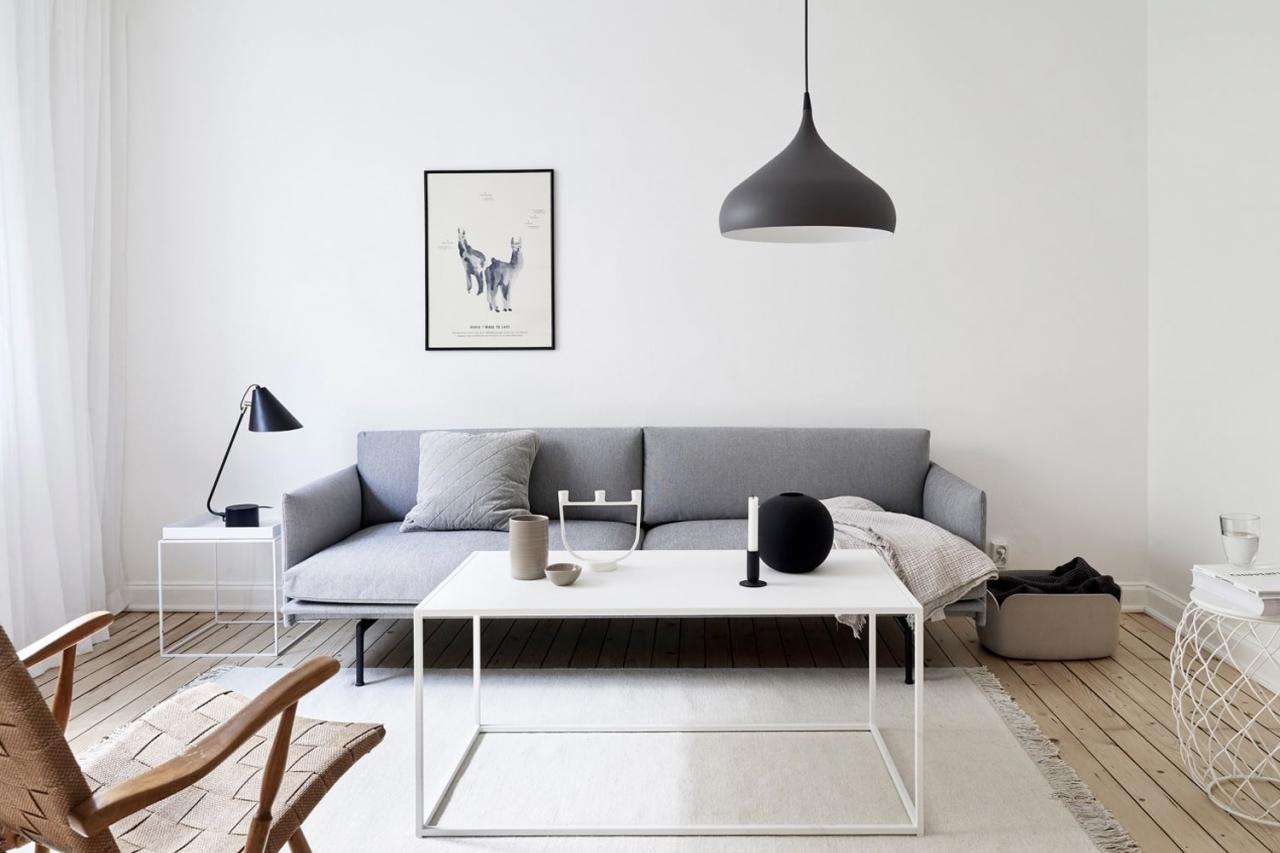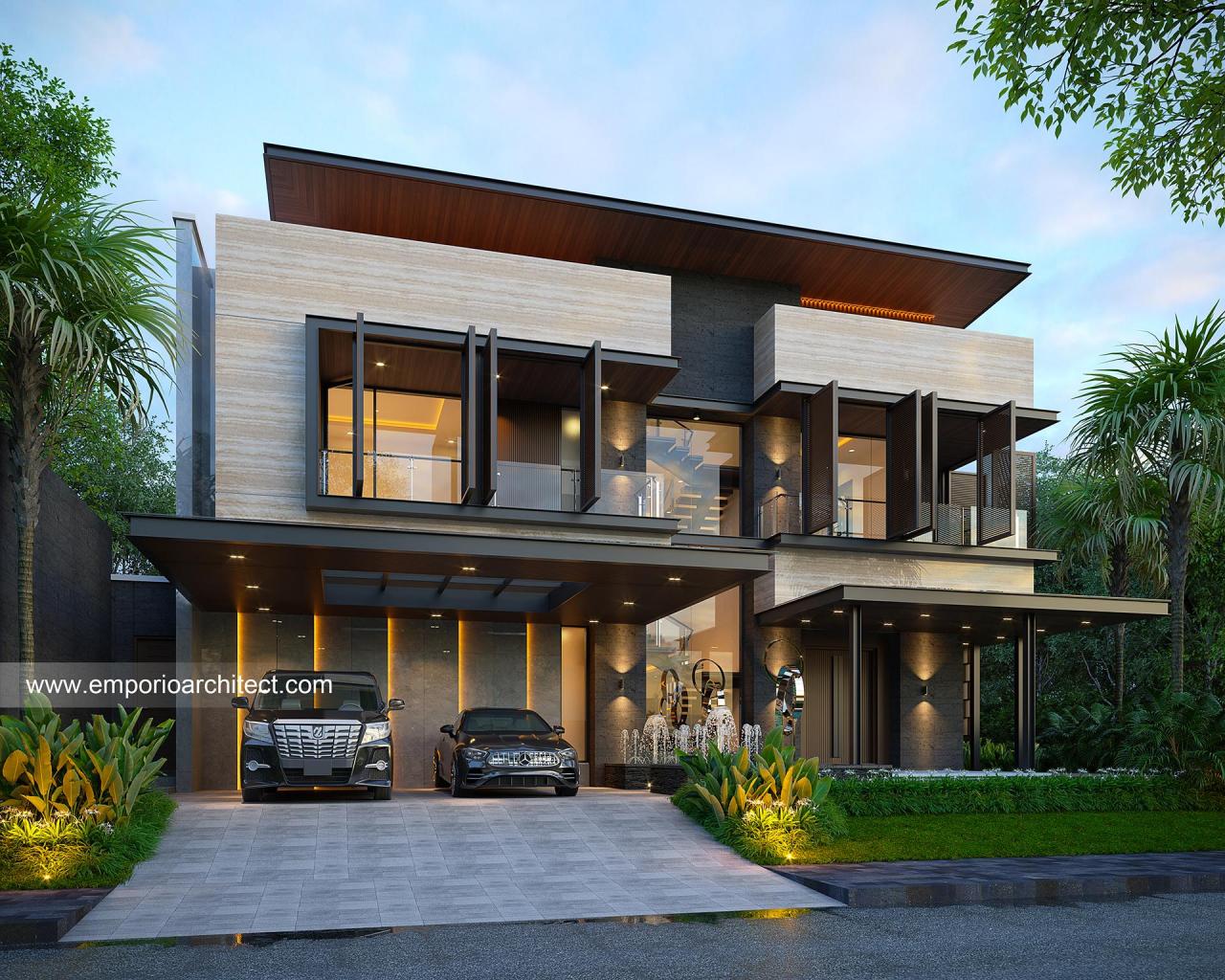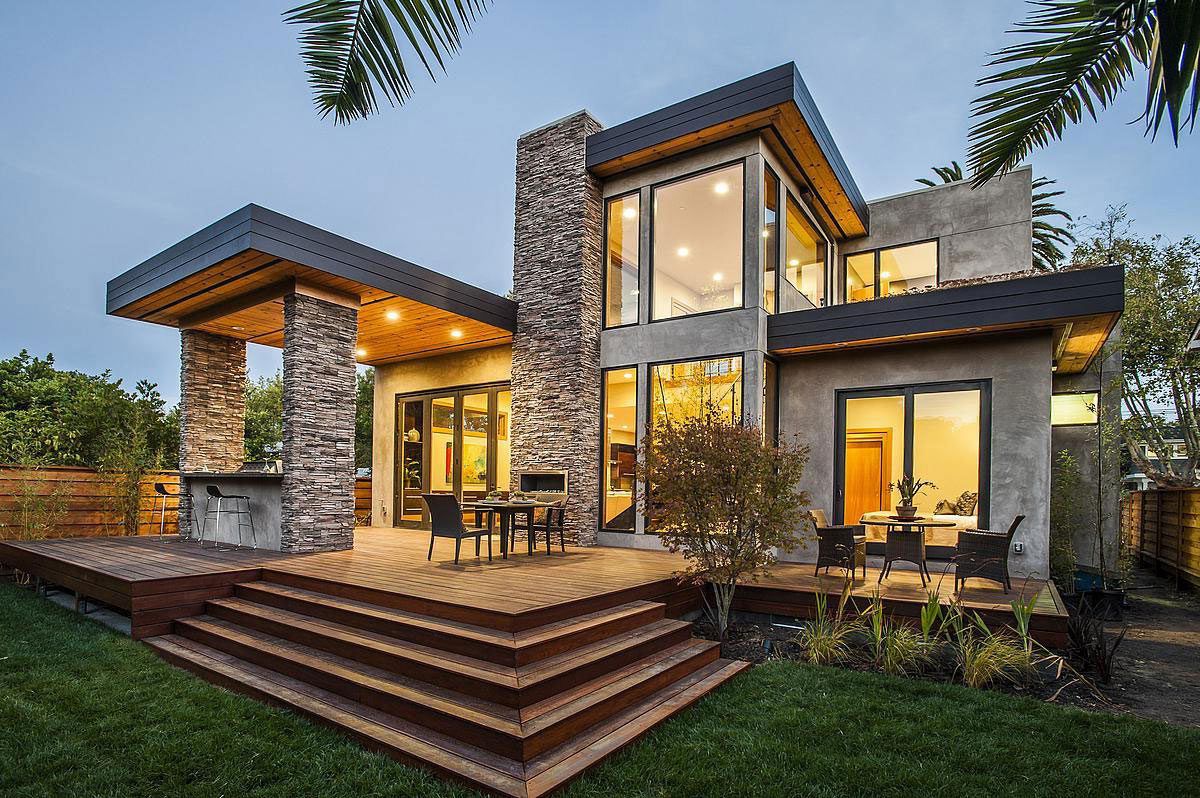Modern home design with a minimalist aesthetic: Imagine a space where less is truly more, where clean lines and functional beauty reign supreme. This isn’t just about decluttering; it’s about creating an intentional, calming sanctuary that reflects your personal style without overwhelming the senses. We’ll delve into the core principles of this design philosophy, exploring color palettes, material choices, furniture selection, and spatial planning to help you craft your own minimalist haven.
From understanding the nuances of natural light integration to mastering the art of strategic storage, we’ll unpack the key elements that define modern minimalist homes. We’ll also showcase stunning examples of minimalist homes, offering inspiration and practical tips for incorporating this aesthetic into your own living space, regardless of size. Get ready to embrace the beauty of simplicity!
Defining Modern Minimalist Home Design

Modern minimalist home design isn’t just about stripping away possessions; it’s a carefully curated aesthetic emphasizing functionality, clean lines, and a sense of calm. It’s about maximizing space and light, creating an environment that feels both sophisticated and effortlessly relaxed. This style prioritizes quality over quantity, focusing on a few well-chosen pieces that serve both practical and aesthetic purposes.Modern minimalist design centers around a few core principles.
Simplicity reigns supreme, with a focus on uncluttered spaces and a limited color palette. Functionality is paramount; every item serves a purpose, contributing to the overall efficiency and flow of the home. Natural materials, such as wood, stone, and concrete, are favored for their inherent beauty and textural qualities. Finally, a sense of spaciousness is achieved through careful planning and the strategic use of light.
Key Characteristics of Modern Minimalist Homes, Modern home design with a minimalist aesthetic
Modern minimalist homes are easily distinguishable from other design styles. Unlike traditional homes, which often feature ornate details and heavily patterned fabrics, minimalist homes embrace clean lines, simple shapes, and a lack of ornamentation. Contemporary styles, while also modern, can incorporate bolder colors and more eclectic furniture choices than the restrained palette and carefully selected pieces typical of a minimalist home.
The key difference lies in the intentional reduction of visual clutter and the emphasis on essential elements. Minimalist spaces are characterized by a sense of calm and order, creating a feeling of spaciousness even in smaller homes.
Modern minimalist home design prioritizes clean lines and functional spaces. Finding the perfect visual representation of this style is key, and that’s where checking out resources like finding the perfect home design photo for my inspiration comes in handy. These resources can help you nail down the exact aesthetic you’re aiming for in your own minimalist haven, inspiring you to create a space that’s both stylish and serene.
Comparison with Traditional and Contemporary Styles
Traditional home design emphasizes ornate details, rich colors, and a sense of history. Think heavy drapes, antique furniture, and intricate moldings. In contrast, modern minimalist design prioritizes simplicity and functionality, favoring clean lines, neutral colors, and uncluttered spaces. Contemporary design, while also modern, often incorporates more diverse materials and bolder color choices. It might include elements of industrial design or mid-century modern aesthetics, resulting in a less austere and more playful atmosphere compared to the deliberate simplicity of a minimalist space.
The difference boils down to the level of ornamentation and the overall feeling of the space: traditional is rich and detailed, contemporary is diverse and potentially eclectic, while minimalist is clean and uncluttered.
The Role of Natural Light in Modern Minimalist Design
Natural light is integral to modern minimalist design. Large windows and skylights are frequently incorporated to maximize the amount of natural light entering the home. This not only illuminates the space but also enhances the sense of openness and spaciousness. The interplay of light and shadow on minimalist surfaces, like clean-lined walls and polished floors, creates a dynamic and visually interesting environment.
The absence of heavy curtains or blinds allows for uninterrupted views of the outdoors, further blurring the lines between interior and exterior spaces. This focus on natural light significantly contributes to the overall aesthetic, creating a bright, airy, and welcoming atmosphere. Think of a Scandinavian-style home, where large windows and light-colored walls are used to maximize the limited daylight hours during winter months – a perfect example of how natural light is harnessed to enhance the minimalist aesthetic.
Modern minimalist home design prioritizes clean lines and functionality, but sustainability shouldn’t be an afterthought. To truly achieve a responsible and stylish space, learn how to incorporate eco-conscious choices by checking out this guide on how to design a modern home with sustainable materials. By using sustainable materials, you can elevate your minimalist aesthetic while minimizing your environmental impact, creating a home that’s both beautiful and ethically sound.
Color Palettes and Material Choices

Modern minimalist design hinges on a carefully curated selection of colors and materials. The goal is to create a sense of calm and spaciousness, letting the architecture and carefully chosen pieces speak for themselves. Overly busy palettes or clashing textures are avoided in favor of a unified, serene aesthetic.A successful modern minimalist space prioritizes quality over quantity, selecting materials known for their durability and inherent beauty.
The interplay of textures, while subtle, plays a crucial role in adding depth and visual interest without disrupting the overall sense of simplicity.
Sample Color Palette for a Modern Minimalist Home
A calming and sophisticated palette is key to achieving the minimalist aesthetic. Consider a base of neutral tones, punctuated by carefully chosen accent colors. For example, a palette might consist of warm whites or off-whites on walls, providing a bright, airy foundation. These could be complemented by various shades of gray for flooring and larger furniture pieces, offering a sense of grounding stability.
Finally, a single, carefully selected accent color – perhaps a deep teal, a muted olive green, or a soft blush pink – could be introduced through smaller items like throw pillows, artwork, or plants, adding a touch of personality without overwhelming the space. This strategic use of color ensures visual harmony and avoids a cluttered or overwhelming feeling.
Materials Commonly Used in Modern Minimalist Homes
Modern minimalist design favors natural and industrial materials for their inherent beauty and functionality. The focus is on showcasing the natural properties of these materials rather than concealing them with elaborate finishes.
| Material | Color | Texture | Use Case |
|---|---|---|---|
| Wood | Light oak, bleached ash, dark walnut | Smooth, grained, polished | Flooring, cabinetry, shelving |
| Concrete | Gray, off-white, polished concrete | Smooth, textured, polished | Flooring, countertops, walls |
| Metal | Brushed steel, black steel, brass | Smooth, brushed, matte | Lighting fixtures, hardware, furniture accents |
| Stone | White marble, gray limestone, black slate | Smooth, veined, rough-hewn | Countertops, flooring, wall cladding |
Combining Different Materials Effectively
The skillful combination of materials is crucial in achieving a sophisticated and balanced aesthetic. For instance, the warmth of light oak wood flooring can be beautifully contrasted with the cool, sleek surface of a polished concrete countertop in a kitchen. The combination of these materials creates visual interest and a sense of harmony. Similarly, the industrial feel of exposed metal shelving can be softened by the organic texture of a woven rug placed underneath.
This careful juxtaposition of materials avoids monotony and adds depth to the overall design. Consider a living room with a concrete feature wall, softened by a plush, light-colored wool rug and complemented by wooden furniture pieces with clean lines. The contrast between the hard, cool concrete and the soft, warm textiles creates a dynamic yet balanced space.
Furniture and Furnishings

Choosing the right furniture is paramount in achieving a truly minimalist modern home. It’s not just about having less; it’s about selecting pieces that are both functional and aesthetically pleasing, contributing to the overall sense of calm and spaciousness. The focus is on quality over quantity, prioritizing pieces that are durable, well-designed, and serve a clear purpose.Furniture selection in a minimalist modern home prioritizes functionality and clean lines.
Cluttered spaces are antithetical to the minimalist aesthetic. Each piece should have a clear purpose, and its design should contribute to the overall feeling of openness and serenity. Avoid overly ornate or fussy designs; instead, opt for pieces with simple, clean lines and a neutral color palette. The emphasis is on form following function, resulting in a space that is both beautiful and practical.
Furniture Examples for Modern Minimalist Design
The core of minimalist furniture design lies in its simplicity and functionality. Think sleek, low-profile sofas with clean lines, made from high-quality materials like leather or linen in neutral tones. A simple, wooden coffee table with a minimalist design, perhaps with tapered legs and a clean-lined top, would complement this perfectly. Similarly, dining chairs should be elegant and understated, perhaps with a simple wooden frame and a comfortable upholstered seat.
Consider a platform bed frame with a low profile, creating a sense of spaciousness in the bedroom. These pieces, while simple, exude sophistication and quality.
Seamless Storage Solutions in Minimalist Design
Storage is crucial in maintaining a minimalist aesthetic. Visible clutter defeats the purpose of minimalism. Built-in shelving, discreetly integrated into the wall, provides ample storage without sacrificing visual appeal. Consider using sleek, minimalist cabinets with handleless doors to maintain a clean, uncluttered look. Modular storage systems offer flexibility and allow you to adapt your storage solutions to your evolving needs.
These systems are often characterized by clean lines and neutral colors, blending seamlessly into the overall design. Utilize ottomans with built-in storage to maximize space and keep items neatly tucked away.
Artwork and Decorative Elements
While minimalism is about simplicity, it doesn’t preclude the inclusion of art or decorative elements. However, the selection process is key. Choose one or two impactful pieces of art, rather than a multitude of smaller items. Large-scale artwork with a simple, clean design can create a focal point without overwhelming the space. Similarly, a few carefully selected decorative objects, such as a simple vase or a sculptural piece, can add subtle interest without detracting from the overall minimalist feel.
The key is to curate a collection of items that are both visually appealing and meaningful, avoiding excessive ornamentation or clutter. Think quality over quantity; a single, striking piece of art is more impactful than a crowded gallery wall.
Space Planning and Layout: Modern Home Design With A Minimalist Aesthetic

Modern minimalist home design prioritizes functionality and a sense of calm. Achieving this requires careful consideration of space planning and layout, focusing on maximizing the use of available area and creating a seamless flow between different zones. Open-plan living is a cornerstone of this approach, offering flexibility and visual spaciousness. However, even in smaller homes, strategic planning can achieve a similar effect.Open-Plan Living in Modern Minimalist HomesOpen-plan living, a defining characteristic of modern minimalist homes, eliminates unnecessary walls to create a unified, airy space.
This approach promotes a sense of freedom and openness, visually expanding the area and improving natural light penetration. The absence of walls allows for a seamless transition between the living, dining, and kitchen areas, fostering a feeling of spaciousness and connectivity. This design encourages social interaction and a more fluid lifestyle, perfect for modern living. However, careful zoning is crucial to maintain a sense of order and prevent the space from feeling chaotic.Maximizing Space and Creating Spaciousness in Smaller HomesIn smaller homes, maximizing space is paramount.
Clever design choices can dramatically enhance the sense of spaciousness. Light-colored walls and flooring visually enlarge the space, reflecting light and creating an airy atmosphere. Mirrors strategically placed can further amplify this effect, doubling the perceived size of a room. Multifunctional furniture, such as sofa beds or ottomans with storage, saves space while maintaining practicality. Minimalist decor, characterized by clean lines and a limited number of furnishings, prevents clutter and maintains a sense of openness.
For example, a small apartment could benefit from a wall-mounted fold-down table that disappears when not in use, maximizing floor space.Modern Minimalist Living Room Floor Plan (Example)A typical modern minimalist living room, measuring approximately 15ft x 12ft (4.5m x 3.6m), could be designed with a focus on clean lines and functionality.
| Item | Dimensions | Placement |
|---|---|---|
| Sofa | 8ft (2.4m) | Against longest wall, centered |
| Coffee Table | 3ft x 3ft (0.9m x 0.9m) | In front of sofa |
| Rug | 9ft x 6ft (2.7m x 1.8m) | Anchoring the sofa and coffee table |
| TV Unit/Media Console | 6ft (1.8m) | On opposite wall, possibly integrated into shelving |
| Floor Lamp | – | Near seating area |
Zoning Techniques to Define Areas within an Open-Plan SpaceEven in open-plan spaces, zoning techniques are crucial for creating distinct areas with specific functions. This can be achieved through the strategic placement of furniture, the use of rugs to delineate zones, variations in flooring materials, or subtle changes in ceiling height. Lighting plays a significant role; different lighting fixtures or intensities can visually separate the living area from the dining area, for example.
A change in flooring material, such as using a different texture or color of wood, can also create a distinct boundary between zones without the need for physical walls. For instance, a darker wood floor in the dining area can subtly differentiate it from a lighter wood floor in the living area. This approach creates a sense of organization and purpose within the overall open-plan design.
Lighting and Ambiance

In a modern minimalist home, lighting isn’t merely functional; it’s a crucial element in shaping the overall mood and atmosphere. The strategic use of different lighting types can transform a space from sterile to inviting, highlighting architectural details and creating a sense of calm or energy, depending on the desired effect. Careful consideration of both natural and artificial light sources is paramount to achieving a truly harmonious and aesthetically pleasing environment.The interplay of ambient, task, and accent lighting is key to achieving the perfect balance in a minimalist space.
Ambient lighting provides overall illumination, task lighting focuses on specific areas for activities, and accent lighting highlights architectural features or artwork, adding depth and visual interest. The right combination of these three types will significantly impact the feeling and functionality of each room.
Ambient Lighting in Minimalist Homes
Ambient lighting sets the overall tone of a room. In minimalist design, this often involves recessed lighting, which provides even, shadow-free illumination, emphasizing clean lines and open spaces. Other options include sleek, linear pendant lights or flush-mounted fixtures that integrate seamlessly into the ceiling. The choice of light color temperature is also important; warmer tones (2700-3000K) create a cozy and inviting atmosphere, while cooler tones (4000-5000K) feel more modern and energizing.
A dimmer switch allows for adjusting the brightness to suit different times of day and moods.
Task Lighting for Functionality
Task lighting focuses light precisely where it’s needed, making activities like reading, working, or applying makeup easier and more comfortable. In a minimalist setting, this might involve a simple, adjustable desk lamp with a minimalist design, a flexible gooseneck reading light attached to the headboard, or strategically placed floor lamps with adjustable arms. These should be chosen to complement the overall aesthetic without overwhelming the space.
The intensity and color temperature should be chosen to optimize the task at hand; for example, a brighter, cooler light is better for focused work, while a warmer, softer light is better for reading.
Accent Lighting to Highlight Features
Accent lighting adds subtle drama and visual interest to a minimalist interior. This is achieved by highlighting specific architectural features, artwork, or decorative objects. Recessed lighting can be used to subtly illuminate niches or wall-mounted shelves, while small, focused spotlights can draw attention to artwork or sculptural elements. LED strip lighting can be discreetly installed under cabinets or behind furniture to create a soft, ambient glow.
The key is to use accent lighting sparingly to avoid overwhelming the clean lines of minimalist design. The use of dimmers allows for subtle control and creates a more dynamic and versatile lighting scheme.
Maximizing Natural Light
Natural light is a valuable asset in any home, and especially so in a minimalist design, where the emphasis is on creating a bright, airy space. Maximizing natural light involves strategically placing windows and using light-colored, reflective surfaces to bounce light around the room. Sheer curtains or blinds can diffuse harsh sunlight while maintaining privacy. Large windows and glass doors are ideal for maximizing natural light intake, but even smaller windows can be optimized by using mirrors to reflect light into darker corners.
Lighting Plan for a Modern Minimalist Bedroom
A minimalist bedroom benefits from a layered lighting approach combining ambient, task, and accent lighting. For ambient lighting, recessed lights in the ceiling provide even illumination. A central pendant light, preferably with a simple, geometric design, can serve as a focal point above the bed. For task lighting, bedside table lamps with adjustable arms offer focused light for reading.
These lamps should have a warm color temperature to create a relaxing atmosphere. Finally, accent lighting could involve a small LED strip light under the bed frame, casting a subtle glow, or a spotlight to highlight a piece of artwork on the wall. Dimmers on all fixtures allow for complete control over the ambiance.
Illustrative Examples of Modern Minimalist Homes

Modern minimalist homes prioritize clean lines, open spaces, and a focus on functionality. They’re a testament to “less is more,” showcasing the beauty of simplicity and the power of thoughtful design. Let’s explore three distinct examples, each reflecting a unique interpretation of this aesthetic.
Examples of Modern Minimalist Home Designs
This first home is characterized by its sleek, geometric exterior. Large windows dominate the facade, maximizing natural light and blurring the lines between indoors and outdoors. The interior features high ceilings, polished concrete floors, and a neutral color palette punctuated by carefully chosen accent pieces. A central open-plan living area seamlessly connects the kitchen, dining, and living spaces, promoting a sense of spaciousness and flow. The overall atmosphere is one of calm sophistication, a sanctuary of understated elegance. Subtle textural contrasts, like the warmth of natural wood against the coolness of concrete, add depth without compromising the minimalist ethos.
In stark contrast, this second home embraces a more rustic minimalist style. Natural materials are central to its design. Reclaimed wood beams accentuate high ceilings, while large stone walls add a grounding element. The interior is warm and inviting, featuring a mix of natural textures and neutral tones. Despite the use of natural materials, the design remains meticulously clean and uncluttered. This home showcases how minimalism can be both modern and deeply connected to nature, creating a space that feels both sophisticated and comforting. The integration of outdoor elements, like a courtyard or garden, further enhances this connection.
This third example showcases a modern minimalist home with a contemporary edge. Clean lines and geometric shapes are prominent, but the use of bold color accents—a vibrant teal in the living room, perhaps, or a deep charcoal in the study—adds personality and visual interest. The design is still minimalist in its essence, prioritizing functionality and open space, but it doesn’t shy away from expressing a strong aesthetic point of view. High-end finishes and sophisticated lighting fixtures elevate the space, creating a sense of luxurious simplicity. This home demonstrates that minimalism doesn’t have to be austere; it can be both sophisticated and stylish.
Modern Minimalist Kitchen Design
A modern minimalist kitchen is defined by its streamlined design and efficient layout. Typically, it features handleless cabinetry, often in a matte white or light gray finish, creating a seamless and uncluttered look. Integrated appliances, such as a built-in refrigerator and dishwasher, further contribute to the clean aesthetic. A large island, often serving as both a workspace and a breakfast bar, is a common feature, providing ample counter space and promoting a sense of openness.
Minimalist pendant lighting hangs above the island, providing focused task lighting. The overall effect is a space that is both beautiful and highly functional.
Natural Materials in a Modern Minimalist Bathroom
Natural materials play a significant role in creating a serene and spa-like atmosphere in a modern minimalist bathroom. Think of warm, light-colored wood for the vanity and shelving, perhaps paired with large, sleek tiles in a neutral tone. A freestanding bathtub, crafted from natural stone or cast iron, adds a touch of elegance. Natural light is maximized through large windows, further enhancing the feeling of tranquility.
Plants, strategically placed, add a touch of life and vibrancy, without disrupting the overall minimalist aesthetic. The overall effect is a bathroom that feels both luxurious and calming, a true sanctuary for relaxation.